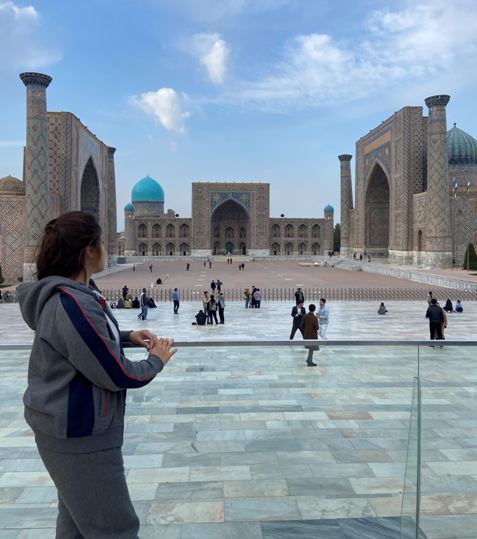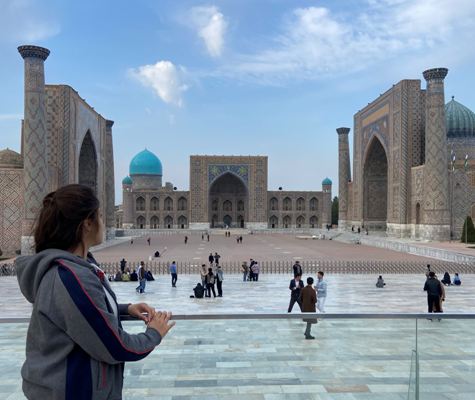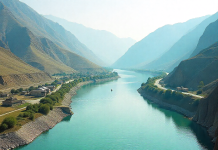Written by Munaza Kazmi
When we read the name Samarkand, unconsciously our mind took us to the blue gigantic monuments, glittering Domes, spices bazaars and to the Kingdom of Timur. Besides, travelling, Samarkand can be more than this, beside it dated back to 6th Century BCE as ancient Afrasiab, when it served the capital of Sogdian Dynasty, with which the city is associated with many archeological sites and a couple of mystical Persian legends.

However, much of the significant development it took was under the region of Timur from 14th to 15th Centuries, when it was center of powerful Temurid realm. And today Samarkand is known as the crossroad of world’s cultures, and corridor of ancient trade.
Located in a large oasis in the valley of the Zerafshan River, in the north-eastern region of Uzbekistan. The historical part of Samarkand consists of three main sections. In the north-east there is the site of the ancient city of Afrosiab, founded in the 6th century BCE and destroyed by Genghis Khan in the 13th century, which is preserved as an archaeological reserve.
Archaeological excavations have revealed the ancient citadel and fortifications, the palace of the ruler and residential and craft quarters. There are also remains of a large ancient mosque built from the 8th to 12th centuries.
Towards the south, there are architectural ensembles and the medieval city of the Temurid epoch of the 14th and 15th centuries, which played a seminal role in the development of town planning, architecture, and arts in the region. Where the old town still contains substantial areas of historic fabric with typical narrow lanes, articulated into districts with social centers, mosques, madrassahs, and residential housing. The traditional Uzbek houses have one or two floors and the spaces are grouped around central courtyards with gardens; built in mud brick, the houses have painted wooden ceilings and wall decorations. The contribution of the Temurid masters to the design and construction of the Islamic ensembles were crucial for the development of Islamic architecture and arts and exercised an important influence in the entire region, leading to the achievements of the Safavids in Persia, the Mughals in India, and even the Ottomans in Turkey.
To the West there is the area that corresponds to the 19th and 20th centuries expansions, built by the Russians, in European style. The modern city extends around this historical zone. This area represents traditional continuity and qualities that are reflected in the neighborhood structure, the small centers, mosques, and houses. Many houses retain painted and decorated interiors, grouped around courtyards and gardens.
The major monuments include the Registan mosque and madrasahs, originally built in mud brick and covered with decorated ceramic tiles, the Bibi-Khanum Mosque and Mausoleum, the Shakhi-Zinda compound, which contains a series of mosques, madrasahs and mausoleum, and the ensembles of Gur-Emir and Rukhabad, as well as the remains of Ulugh-Bek’s Observatory and the Tomb of Imam Bukhari.
The monuments are well maintained, however, some of the medieval features have been lost, such as the city walls and the citadel, as well as parts of the traditional residential structures especially in areas surrounding major monuments. Nevertheless, it still contains a substantial urban fabric of traditional Islamic quarters, with some fine examples of traditional houses, but on the whole it’s on the edge of fading.
The architectural ensembles of Samarkand as well as archacological remains of Afrosiab preserved all characteristic features related to the style and techniques and have maintained traditional spatial plans of the urban quarter. However, inadequate restoration intervention well as the challenges faced in controlling changes, particularly the construction of mod buildings, and the modemization on private properties have affected the authenticity of property and make the property vulnerable to further changes.
Looking upon the social and cultural ethos, the Uzbeks seem to lost the respect of religion and their customs, as they openly denounce Islam, saying Uzbekistan is a Democratic country not Islamic, plus the wine is an everyday business, night clubs, and bars are operating freely, people specially youth don’t follow the basic Islamic laws. More to say they don’t even respect the name of Taimur, as everybody was entering into the tomb without even removing their shoe.
However, with this there were obviously some positive perspectives of the country , one such thing was that, they reserved I think specially in Samarkand Monday for cleaning, however I found more women than men in this occupation.
On the whole, I found Samarkand average, excluding the old blue architecture.

















